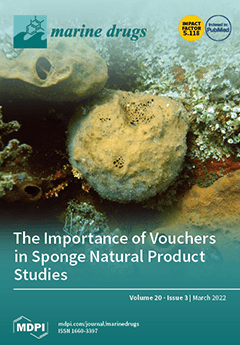Seaweed endophytic (algicolous) fungi are talented producers of bioactive natural products. We have previously isolated two strains of the endophytic fungus,
Pyrenochaetopsis sp. FVE-001 and FVE-087, from the thalli of the brown alga
Fucus vesiculosus. Initial chemical studies yielded four new decalinoylspirotetramic
[...] Read more.
Seaweed endophytic (algicolous) fungi are talented producers of bioactive natural products. We have previously isolated two strains of the endophytic fungus,
Pyrenochaetopsis sp. FVE-001 and FVE-087, from the thalli of the brown alga
Fucus vesiculosus. Initial chemical studies yielded four new decalinoylspirotetramic acid derivatives with antimelanoma activity, namely pyrenosetins A–C (
1–
3) from
Pyrenochaetopsis sp. strain FVE-001, and pyrenosetin D (
4) from strain FVE-087. In this study, we applied a comparative metabolomics study employing HRMS/MS based feature-based molecular networking (FB MN) on both
Pyrenochaetopsis strains. A higher chemical capacity in production of decalin derivatives was observed in
Pyrenochaetopsis sp. FVE-087. Notably, several decalins showed different retention times despite the same MS data and MS/MS fragmentation pattern with the previously isolated pyrenosetins, indicating they may be their stereoisomers. FB MN-based targeted isolation studies coupled with antimelanoma activity testing on the strain FVE-087 afforded two new stereoisomers, pyrenosetins E (
5) and F (
6). Extensive NMR spectroscopy including DFT computational studies, HR-ESIMS, and Mosher’s ester method were used in the structure elucidation of compounds
5 and
6. The 3’
R,5’
R stereochemistry determined for compound
6 was identical to that previously reported for pyrenosetin C (
3), whose stereochemistry was revised as 3’
S,5’
R in this study. Pyrenosetin E (
5) inhibited the growth of human malignant melanoma cells (A-375) with an IC
50 value of 40.9 μM, while
6 was inactive. This study points out significant variations in the chemical repertoire of two closely related fungal strains and the versatility of FB MN in identification and targeted isolation of stereoisomers. It also confirms that the little-known fungal genus
Pyrenochaetopsis is a prolific source of complex decalinoylspirotetramic acid derivatives.
Full article






